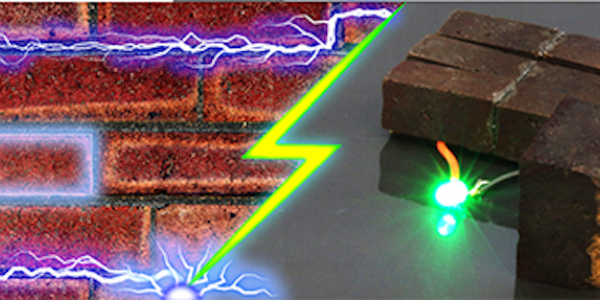Imagine plugging in to your brick house.
Red bricks — some of the world’s cheapest and most familiar building materials — can be converted into energy storage units that can be charged to hold electricity, like a battery, according to new research from D'Arcy Lab.
Brick has been used in walls and buildings for thousands of years, but rarely has it been found fit for any other use. Now, as reported in the Source, chemists in Arts & Sciences have developed a method to make or modify “smart bricks” that can store energy until required for powering devices. A proof-of-concept published August 11 in Nature Communications (and pictured below) shows a brick directly powering a green LED light.
“Our method works with regular brick or recycled bricks, and we can make our own bricks as well,” said Julio D’Arcy, assistant professor of chemistry. “As a matter of fact, the work that we have published in Nature Communications stems from bricks that we bought at Home Depot right here in Brentwood (Missouri); each brick was 65 cents.”
Walls and buildings made of bricks already occupy large amounts of space, which could be better utilized if given an additional purpose for electrical storage. While some architects and designers have recognized the humble brick’s ability to absorb and store the sun’s heat, this is the first time anyone has tried using bricks as anything more than thermal mass for heating and cooling.
D’Arcy and colleagues, including Washington University graduate student Hongmin Wang, first author of the new study, showed how to convert red bricks into a type of energy storage device called a supercapacitor.
“In this work, we have developed a coating of the conducting polymer PEDOT, which is comprised of nanofibers that penetrate the inner porous network of a brick; a polymer coating remains trapped in a brick and serves as an ion sponge that stores and conducts electricity,” D’Arcy said.
The red pigment in bricks — iron oxide, or rust — is essential for triggering the polymerisation reaction. The authors’ calculations suggest that walls made of these energy-storing bricks could store a substantial amount of energy.
This research has garnered substantial media attention, including from CNN, the Guardian, Vice, IFL Science, and the St. Louis Post-Dispatch.
“We discovered that if you treat rust chemically, it actually becomes reactive,” D’Arcy explained. “So something that we typically think of as waste turns out to be a useful chemical for producing materials that can be used for storing energy.”
“What we have demonstrated in our paper is sufficient enough for you to light up emergency lighting that's in a hallway or sensors that could be embedded inside the walls of a house,” D'Arcy added. “The next step is trying to store more energy, so that you can power bigger devices — like maybe a laptop — directly from the walls of the house.”
Read more about D'Arcy Lab's related work on turning rust into microsupercapacitors.






